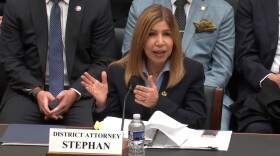San Diego water managers exude an understated confidence when they talk about the regional drought that is drying up California and the Colorado River Basin.
“Despite the fact that we’ve developed the supplies and have the water available, it’s never okay to waste and we’re always moving toward becoming more efficient with that water that we do have,” said Jeff Stephenson of the San Diego County Water Authority in a July interview with KPBS.
Earlier this year the SDCWA touted the fact that even if the current drought persisted, they would have a sustainable supply of water for years.
That message may be muted now because Gov. Gavin Newsom is stepping up calls for Californians to conserve water. Still, local officials are confident they are prepared for just this situation.
But the San Diego County Water Authority cannot plan for everything, and the punishing mega drought squeezing the Colorado River could yet influence how much water San Diego ends up drawing from an important source of drinking water.
When it comes to water infrastructure, San Diego water managers, have spent billions to accumulate their embarrassment of riches.
The region has a desalination plant that turns 50 million gallons of ocean water into tap water every day.
There’s a new higher dam at the San Vicente reservoir near Lakeside that holds more water than it used to.
And the Olivenhain reservoir near Escondido is full, a rarity for a human-made lake in the west these days.
“The reservoir is a 24,000 acre foot reservoir that supplies water to our aqueduct,” said Nadir Baig, a dam operator at Olivenhain.
That’s a year’s supply of water for about 60,000 families. Olivenhain also generates electricity as water is transferred back and forth between it and Lake Hodges.
But the water stored there is a backup plan if the region’s imported supplies — about half of the water used in the region — gets cut off.
San Diego County water officials spent a lot of money securing expensive water transfer agreements with the Imperial Valley, meaning San Diego would be among the last users to face cuts if shortages force reductions.
The San Diego County Water Authority estimates there is a six month supply of water in local reservoirs.
“We are secure, but we still need to do our part,” said Kelly Rodgers, the director of the Colorado River Program at the water authority. “Because these hotter, dryer conditions are our foreseeable future.”
Thirty years of planning has allowed the region to cope, she said.
“It’s like your retirement,” she said. “When you’re younger, ‘You’re like, oh gosh, I may never need that.’ But when you’re retired, you’re like, ‘Wow, all the investments are paying off.’”
But San Diego is not immune from the water crisis bubbling through the Colorado River Basin.

Courtesy of Brian Lorenz
The Federal Bureau of Reclamation’s top official said at a recent U.S. Senate Committee hearing that all of the west’s watersheds are suffering.
“Hydrological variability,” said Camille Calimlim Touton, the Bureau of Reclamation’s commissioner. “Hotter temperatures leading to earlier snowmelt. Dry soils, all translating into earlier and low runoff. This is coupled, as the committee has mentioned, with the lowest reservoir levels on record.”
The bureau is charged with managing the Colorado River and the agency has twice called for river users to cut back the amount of water they take.
That is unprecedented, and Touton told lawmakers more drastic cuts are needed.
“Between two and four million acres feet of additional conservation is needed just to protect critical levels in 2023,” she said.
The critical levels she talked about are water levels in Lake Powell and Lake Mead, the west’s largest reservoirs which are fed by the Colorado River.
Water levels there are falling at alarming rates. In 23 years of drought since the year 2000, Lake Mead has lost 170 feet of elevation, said Michael Cohen, a senior researcher at the Pacific Institute, a water issues think tank.

“And the forecasts are projecting that Lake Mead could drop even another 50 feet in the next two years,” he said.
That could put the system dangerously close to a condition water managers call “dead pool.”
That happens when the lake’s level drops below the valves that allow water to pass by the Hoover and Glen Canyon dams. Lake Mead could be just 100 feet away from “dead pool” if current projections hold and more cutbacks do not have an impact.
San Diego stands to lose half of its drinking water if those reservoir water levels drop too low.
The expensive senior water rights, bought from the Imperial Irrigation District, would be worthless.
“There’s a chance that if the different Colorado River water users can’t come to an agreement that current rules will continue to apply, and that Lake Mead will continue to be drawn down,” Cohen said. “Creating the crisis that we’re really seeing right now because people see this coming.”
And while water managers may see the crisis coming, it is never easy negotiating scarcity.
“These are very complex discussions,” Rodgers said. “The solutions are complex. It’s going to take some time to come up with a proposal. There are a lot of water users affected.”
Federal officials want water users to make the decisions, but say they will step in if needed.
Meanwhile, California may actually draw more water than is allocated this year.
“And most of that overuse,” Cohen said. “Is actually not coming from the irrigation district, it's coming from Metropolitan Water District. And that’s because California itself is in a massive drought.”
Metropolitan is the region’s largest water wholesaler, serving Los Angeles and many surrounding water districts.
The consequences of taking too much water now could be dire.
So far, California has avoided the first two rounds of cuts, but that likely will not be the case next year.
The unanswered question right now is whether San Diego will lose just a slice of its Colorado River water in coming years, or if the basin’s water use cannot be reined in and San Diego loses it all.
-
San Diego County may not be immune from a punishing drought threatening the supply of Colorado River water.
-
The FDA gave emergency use authorization to the booster today and a CDC panel review is scheduled Thursday.













